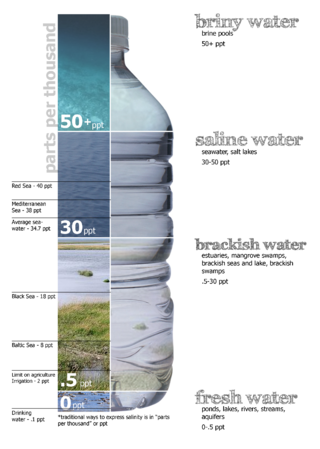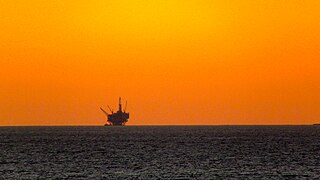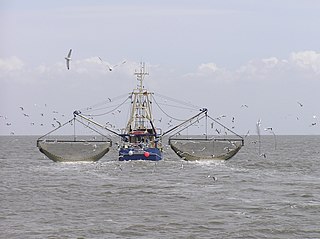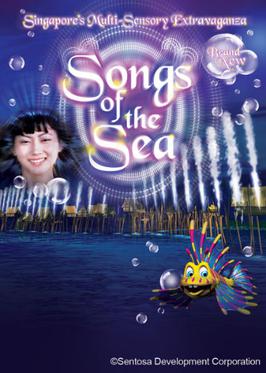
Brackish water, sometimes termed brack water, is water occurring in a natural environment that has more salinity than freshwater, but not as much as seawater. It may result from mixing seawater and fresh water together, as in estuaries, or it may occur in brackish fossil aquifers. The word comes from the Middle Dutch root brak. Certain human activities can produce brackish water, in particular civil engineering projects such as dikes and the flooding of coastal marshland to produce brackish water pools for freshwater prawn farming. Brackish water is also the primary waste product of the salinity gradient power process. Because brackish water is hostile to the growth of most terrestrial plant species, without appropriate management it can be damaging to the environment.

A coast – also called the coastline, shoreline, or seashore – is the land next to the sea or the line that forms the boundary between the land and the ocean or a lake. Coasts are influenced by the topography of the surrounding landscape, as well as by water induced erosion, such as waves. The geological composition of rock and soil dictates the type of shore that is created. Earth contains roughly 620,000 km (390,000 mi) of coastline.

A dory is a small, shallow-draft boat, about 5 to 7 metres or 16 to 23 feet long. It is usually a lightweight boat with high sides, a flat bottom and sharp bows. It is easy to build because of its simple lines. For centuries, the dory has been used as a traditional fishing boat, both in coastal waters and in the open sea.

Fish farming or pisciculture involves commercial breeding of fish, most often for food, in fish tanks or artificial enclosures such as fish ponds. It is a particular type of aquaculture, which is the controlled cultivation and harvesting of aquatic animals such as fish, crustaceans, molluscs and so on, in natural or pseudo-natural environments. A facility that releases juvenile fish into the wild for recreational fishing or to supplement a species' natural numbers is generally referred to as a fish hatchery. Worldwide, the most important fish species produced in fish farming are carp, catfish, salmon and tilapia.

An oil platform is a large structure with facilities to extract and process petroleum and natural gas that lie in rock formations beneath the seabed. Many oil platforms will also have facilities to accommodate the workers, although it is also common to have a separate accommodation platform linked by bridge to the production platform. Most commonly, oil platforms engage in activities on the continental shelf, though they can also be used in lakes, inshore waters, and inland seas. Depending on the circumstances, the platform may be fixed to the ocean floor, consist of an artificial island, or float. In some arrangements the main facility may have storage facilities for the processed oil. Remote subsea wells may also be connected to a platform by flow lines and by umbilical connections. These sub-sea facilities may include one or more subsea wells or manifold centres for multiple wells.

Biscayne National Park is an American national park located south of Miami, Florida in Miami-Dade County. The park preserves Biscayne Bay and its offshore barrier reefs. Ninety-five percent of the park is water, and the shore of the bay is the location of an extensive mangrove forest. The park covers 172,971 acres and includes Elliott Key, the park's largest island and northernmost of the true Florida Keys, formed from fossilized coral reef. The islands farther north in the park are transitional islands of coral and sand. The offshore portion of the park includes the northernmost region of the Florida Reef, one of the largest coral reefs in the world.
Pulau Semakau is located to the south of the main island of Singapore, off the Straits of Singapore. The Semakau Landfill is located on the eastern side of the island, and was created by the amalgamation of Pulau Sakeng, and "anchored" to Pulau Semakau. The Semakau Landfill is Singapore's first offshore landfill and now the only remaining landfill in Singapore.

Pelagic fish live in the pelagic zone of ocean or lake waters—being neither close to the bottom nor near the shore—in contrast with demersal fish that live on or near the bottom, and reef fish that are associated with coral reefs.

Demersal fish, also known as groundfish, live and feed on or near the bottom of seas or lakes. They occupy the sea floors and lake beds, which usually consist of mud, sand, gravel or rocks. In coastal waters, they are found on or near the continental shelf, and in deep waters, they are found on or near the continental slope or along the continental rise. They are not generally found in the deepest waters, such as abyssal depths or on the abyssal plain, but they can be found around seamounts and islands. The word demersal comes from the Latin demergere, which means to sink.

The mangrove snapper or gray snapper is a species of snapper native to the western Atlantic Ocean from Massachusetts to Brazil, the Gulf of Mexico, Bermuda, and the Caribbean Sea. The species can be found in a wide variety of habitats, including brackish and fresh waters. It is commercially important and is sought as a game fish. It can also be found in the aquarium trade.

Very large floating structures (VLFSs) or very large floating platforms (VLFPs) are artificial islands, which may be constructed to create floating airports, bridges, breakwaters, piers and docks, storage facilities, wind and solar power plants, for military purposes, to create industrial space, emergency bases, entertainment facilities, recreation parks, mobile offshore structures and even for habitation. Currently, several different concepts have been proposed for building floating cities or huge living complexes. Some units have been constructed and are presently in operation.

Serangoon Harbour is a harbour in Singapore located between the mainland island of Singapore and Pulau Ubin.

Offshore drilling is a mechanical process where a wellbore is drilled below the seabed. It is typically carried out in order to explore for and subsequently extract petroleum that lies in rock formations beneath the seabed. Most commonly, the term is used to describe drilling activities on the continental shelf, though the term can also be applied to drilling in lakes, inshore waters and inland seas.

A fishing vessel is a boat or ship used to catch fish and other valuable nektonic aquatic animals in the sea, lake or river. Humans have used different kinds of surface vessels in commercial, artisanal and recreational fishing.

Recreational fishermen usually fish either from a boat or from a shoreline or river bank. When fishing from a boat, or fishing vessel, most fishing techniques can be used, from nets to fish traps, but some form of angling is by far the most common. Compared to fishing from the land, fishing from a boat allows more access to different fishing grounds and different species of fish.

Traditionally, many different kinds of boats have been used as fishing boats to catch fish in the sea, or on a lake or river. Even today, many traditional fishing boats are still in use. According to the United Nations Food and Agriculture Organization (FAO), at the end of 2004, the world fishing fleet consisted of about 4 million vessels, of which 2.7 million were undecked (open) boats. While nearly all decked vessels were mechanised, only one-third of the undecked fishing boats were powered, usually with outboard engines. The remaining 1.8 million boats were traditional craft of various types, operated by sail and oars.

Coastal fish, also called inshore fish or neritic fish, inhabit the sea between the shoreline and the edge of the continental shelf. Since the continental shelf is usually less than 200 metres (660 ft) deep, it follows that pelagic coastal fish are generally epipelagic fish, inhabiting the sunlit epipelagic zone. Coastal fish can be contrasted with oceanic fish or offshore fish, which inhabit the deep seas beyond the continental shelves.

The fishing industry in Brunei is one of the largest contributors of the country's revenue. Fishing is a major source of protein in the diets of the Brunei people. The coastal location on the island of Borneo makes it an ideal location for commercial and subsistence fishing.

Songs of the Sea was a multimedia show located at Siloso Beach on Sentosa Island, Singapore. Designed by ECA2 founder, Yves Pépin, Songs of the Sea started its operations on 26 March 2007, a day after the Sentosa Musical Fountain ceased operations. The fountain is a $30 million investment by Sentosa to enhance its entertainment product offerings and to attract more tourists. It was the world's only permanent show set in the sea – with pyrotechnics displays, water jets that could shoot up to 40 meters, laser show, flame bursts, a live 7-person cast, and an open-air viewing gallery which can accommodate 3,000 visitors. Songs of the Sea had its final show on 4 May 2014, and was closed to make way for a brand new multi-sensory production titled Wings of Time, which was launched on 17 June that year.

Offshore aquaculture, also known as open water aquaculture or open ocean aquaculture, is an emerging approach to mariculture where fish farms are positioned in deeper and less sheltered waters some distance away from the coast, where the cultivated fish stocks are exposed to more naturalistic living conditions with stronger ocean currents and more diverse nutrient flow. Existing "offshore" developments fall mainly into the category of exposed areas rather than fully offshore. As maritime classification society DNV GL has stated, development and knowledge-building are needed in several fields for the available deeper water opportunities to be realized.





















